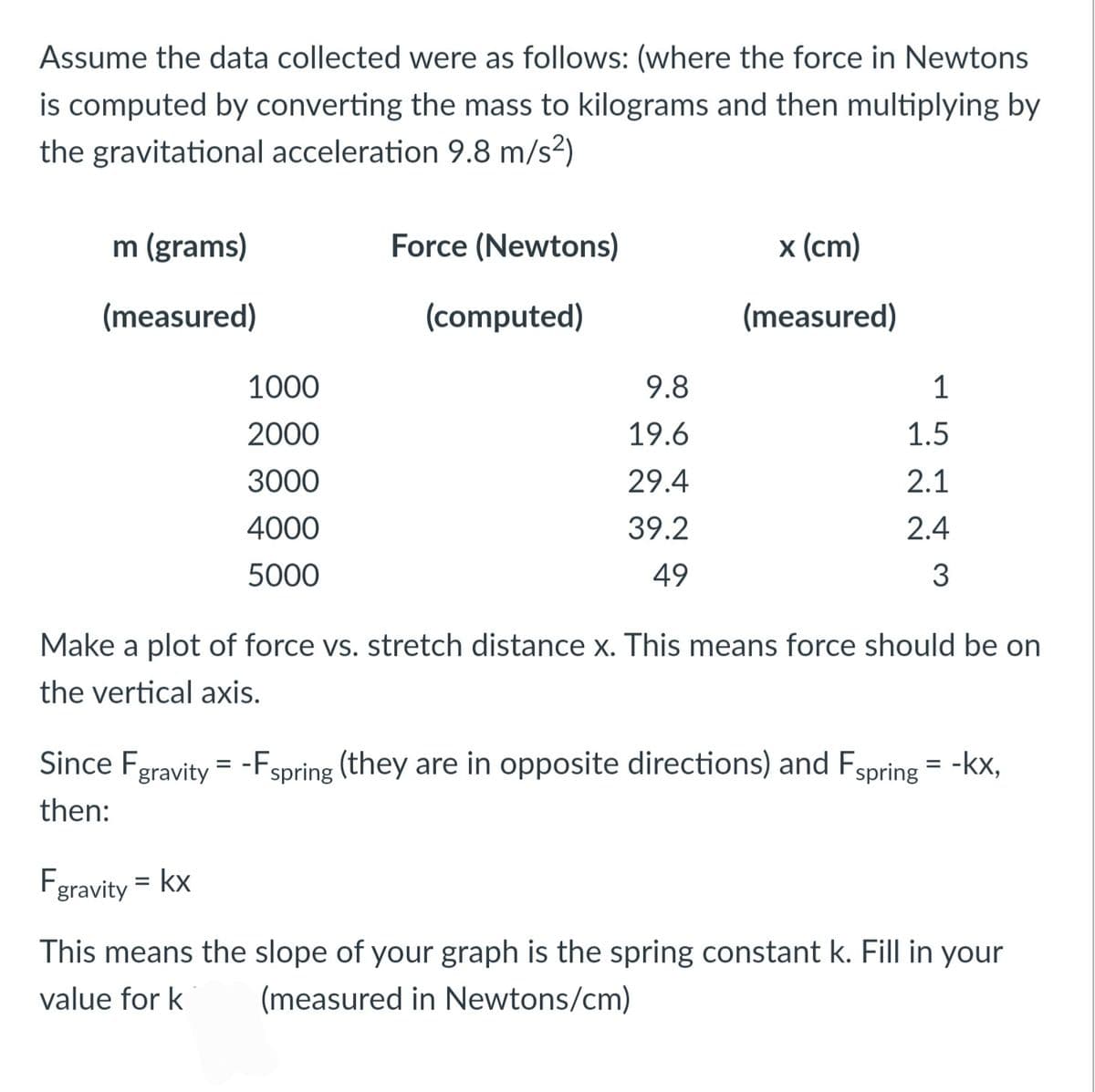Assume the data collected were as follows: (where the force in Newtons is computed by converting the mass to kilograms and then multiplying by the gravitational acceleration 9.8 m/s²) m (grams) Force (Newtons) x (cm) (measured) (computed) (measured) 1000 9.8 1 2000 19.6 1.5 3000 29.4 2.1 4000 39.2 2.4 5000 49 3 Make a plot of force vs. stretch distance x. This means force should be on the vertical axis. Since Fgravity = -Fspring (they are in opposite directions) and Fspring = -kx, then: Fgravity = kx This means the slope of your graph is the spring constant k. Fill in your value for k (measured in Newtons/cm)
Assume the data collected were as follows: (where the force in Newtons is computed by converting the mass to kilograms and then multiplying by the gravitational acceleration 9.8 m/s²) m (grams) Force (Newtons) x (cm) (measured) (computed) (measured) 1000 9.8 1 2000 19.6 1.5 3000 29.4 2.1 4000 39.2 2.4 5000 49 3 Make a plot of force vs. stretch distance x. This means force should be on the vertical axis. Since Fgravity = -Fspring (they are in opposite directions) and Fspring = -kx, then: Fgravity = kx This means the slope of your graph is the spring constant k. Fill in your value for k (measured in Newtons/cm)
Principles of Physics: A Calculus-Based Text
5th Edition
ISBN:9781133104261
Author:Raymond A. Serway, John W. Jewett
Publisher:Raymond A. Serway, John W. Jewett
Chapter11: Gravity, Planetary Orbits, And The Hydrogen Atom
Section: Chapter Questions
Problem 47P: Let gM represent the difference in the gravitational fields produced by the Moon at the points on...
Related questions
Question
100%
The class I'm taking is physics for scientists and engineers!
I am completely stuck. Need help. I have attached the problem. Please view attachment before answering. Please write step-by-step solution so I can fully understand. Thank you!

Transcribed Image Text:Assume the data collected were as follows: (where the force in Newtons
is computed by converting the mass to kilograms and then multiplying by
the gravitational acceleration 9.8 m/s²)
m (grams)
Force (Newtons)
x (cm)
(measured)
(computed)
(measured)
1000
9.8
1
2000
19.6
1.5
3000
29.4
2.1
4000
39.2
2.4
5000
49
3
Make a plot of force vs. stretch distance x. This means force should be on
the vertical axis.
Since Fgravity = -Fspring (they are in opposite directions) and Fspring = -kx,
then:
Fgravity = kx
This means the slope of your graph is the spring constant k. Fill in your
value for k (measured in Newtons/cm)
Expert Solution
This question has been solved!
Explore an expertly crafted, step-by-step solution for a thorough understanding of key concepts.
This is a popular solution!
Trending now
This is a popular solution!
Step by step
Solved in 2 steps with 1 images

Knowledge Booster
Learn more about
Need a deep-dive on the concept behind this application? Look no further. Learn more about this topic, physics and related others by exploring similar questions and additional content below.Recommended textbooks for you

Principles of Physics: A Calculus-Based Text
Physics
ISBN:
9781133104261
Author:
Raymond A. Serway, John W. Jewett
Publisher:
Cengage Learning

Physics for Scientists and Engineers: Foundations…
Physics
ISBN:
9781133939146
Author:
Katz, Debora M.
Publisher:
Cengage Learning

Classical Dynamics of Particles and Systems
Physics
ISBN:
9780534408961
Author:
Stephen T. Thornton, Jerry B. Marion
Publisher:
Cengage Learning

Principles of Physics: A Calculus-Based Text
Physics
ISBN:
9781133104261
Author:
Raymond A. Serway, John W. Jewett
Publisher:
Cengage Learning

Physics for Scientists and Engineers: Foundations…
Physics
ISBN:
9781133939146
Author:
Katz, Debora M.
Publisher:
Cengage Learning

Classical Dynamics of Particles and Systems
Physics
ISBN:
9780534408961
Author:
Stephen T. Thornton, Jerry B. Marion
Publisher:
Cengage Learning

University Physics Volume 1
Physics
ISBN:
9781938168277
Author:
William Moebs, Samuel J. Ling, Jeff Sanny
Publisher:
OpenStax - Rice University

Glencoe Physics: Principles and Problems, Student…
Physics
ISBN:
9780078807213
Author:
Paul W. Zitzewitz
Publisher:
Glencoe/McGraw-Hill

Stars and Galaxies
Physics
ISBN:
9781305120785
Author:
Michael A. Seeds, Dana Backman
Publisher:
Cengage Learning